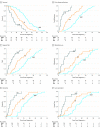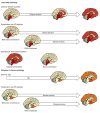Prognosis and Neuropathologic Correlation of Clinical Subtypes of Parkinson Disease
- PMID: 30640364
- PMCID: PMC6459129
- DOI: 10.1001/jamaneurol.2018.4377
Prognosis and Neuropathologic Correlation of Clinical Subtypes of Parkinson Disease
Abstract
Importance: Clinical subtyping of Parkinson disease at diagnosis is useful in estimating disease course and survival. Severity and rate of progression of neuropathologies are important determinants of clinical Parkinson subtypes.
Objective: To provide longitudinal clinical disease-course data and neuropathologic correlation for newly proposed Parkinson disease subtypes.
Design, setting, and participants: Retrospective cohort study of consecutive patients with autopsy-confirmed Parkinson disease who were regularly seen throughout their disease course by hospital specialists in the United Kingdom and donated their brain at death to the Queen Square Brain Bank between January 2009 and December 2017. Patients with additional neuropathologic diagnoses, monogenic forms of parkinsonism, or insufficiently detailed clinical information were excluded. Based on severity of motor symptoms, rapid eye movement sleep behavior disorder, and autonomic and cognitive function at diagnosis, patients were classified adapting a subtyping classification into mild-motor predominant, intermediate, or diffuse malignant subtypes.
Main outcomes and measures: Time from diagnosis to disease milestones (recurrent falls, wheelchair dependence, dementia, and care home placement) and death were compared between subtypes, and their risk was estimated using Cox hazard regression models. Severity and distribution of Lewy pathology and Alzheimer disease-related pathology were assessed using staging systems.
Results: From a total of 146 patients, 111 patients were included (67 men [60.4%]; mean [SD] age at diagnosis, 62.5 [11.5] years). The diffuse malignant subtype had earlier development of milestones and reduced survival. Cox proportional hazard regression showed an increased adjusted risk of any disease milestone (hazard ratio, 10.90; 95% CI, 5.51-21.58; P < .001) and death (hazard ratio, 3.65; 95% CI, 1.98-6.75; P < .001) in the diffuse malignant group. Age at diagnosis was the only additional variable with statistical significance (adjusted hazard ratio for death, 1.14; 95% CI, 1.11-1.17; P <.001). Staging of Lewy pathology and Alzheimer disease-related pathology did not differ between subtypes, although they showed different rates of progression, and the latter was associated with age at death.
Conclusions and relevance: Parkinson clinical subtypes at diagnosis may estimate disease course and survival, which may be useful in providing a more accurate prognosis in individual patients in clinical practice and helping to stratify subgroups in clinical trials. Different severity and progression of neuropathologies are important determinants of Parkinson subtypes, and age at diagnosis should be included in future subtype classifications.
Conflict of interest statement
Figures



References
Publication types
MeSH terms
Grants and funding
LinkOut - more resources
Full Text Sources
Other Literature Sources
Medical

